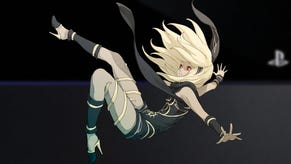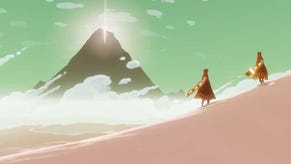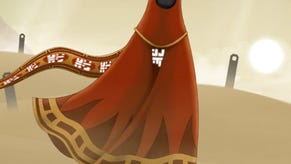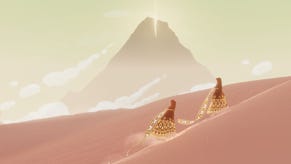thatgamecompany’s Journey is a “unique, beautiful thing”
thatgamecompany's Jenova Chen talks about the studio's next title Journey as we see a new demo for the game in London.
Hidden amongst the noise and bombast of Sony's 2011 launch line-up – a selection that includes Motorstorm, Resistance 3, Uncharted 3 and many other loud, self-assured blockbusters – there is a quiet but fascinating character that stands out from the rest: Journey. It's a lovely-looking new puzzle adventure game from thatgamecompany, previously of Flow and Flower fame. In a recent London presentation, studio founder Jenova Chen showed off the game's gorgeous, sand-covered world and explained the ideology behind its seamless, lobby-free, almost passive multiplayer.
Journey is a unique and beautiful thing. Where most games want to empower you, Journey renders you tiny and powerless in the vastness of nature. You play a faceless traveller, wrapped in billowing red nomadic robes. Alone in a desert of clear, calm, endless sand, you see a mountain in the far distance, and the only goal is to reach it. You have no superpowers and no guidance – just dots on the horizon to explore. Instead of a sense of power, it evokes a sense of wonder.
“Most games today are very clear about what you have to do, who you are, where are your waypoints and goals – but we wanted to present an experience where you don't necessarily know who you are, or what's happening,” Chen says. “You're in the middle of the desert and there's nothing around you. We want to use design to drive you through the game with intuition and curiosity – and let you go at your own pace. There'd nobody shouting at you to get to Checkpoint B.”
Journey's is a world built from sand – and what stunningly rendered sand it is. It settles in dunes, undulates and flows, swirls gorgeously in the wind and streams like a waterfall over cliffs. The nomad's footprints fill up again quickly in his (or her?) wake. He surfs down the sides of dunes, leaving behind a winding trail. The controls, as in all of thatgamecompany's creations, are beautifully simple – there isn't even a jump button, just the analogue stick and sixaxis tilting to move the camera.
"We want to use design to drive you through the game with intuition and curiosity..."
Aside from the eventual goal of reaching the mountain, the actual content of the game is mysterious. The storytelling is passive, relying on implication rather than text and dialogue; like Ico, it's easier to understand it the second or third time through. At first, you'll just make your way towards whatever looks interesting. We're shown broken ruins, half-buried in the drifts in the middle distance; within, Chen finds a magic ribbon. Touching it transforms it into a scarf that trails behind the nomad and gives him the temporary power of flight.
Essentially, it's an exploratory puzzler. Finding more ribbons increases the length of the scarf, and catching scraps of material floating in the air seems to top up its flight power. It's very tactile – touch the fluttering grey flags that reach out towards the sky, and they'll turn a bright crimson, acting like switches that change something else in the immediate surroundings.
Now and then as you venture through the desert, you'll catch sight of another nomad in the distance. Fascinatingly, Journey is always passively matching you up with other players at a similar point in the game, without you having to so much as enter a menu, or leave your game to join someone else's. These meetings are entirely anonymous, and non-binding; should you continue to wander in your own direction rather than engage with a stranger across the dunes, you'll simply be disconnected without either of you knowing it.
There are no leaderboards, no menus, and there's no competition – as Chen explains, thatgamecompany's inspiration was to remove the competitive element from online gaming. “We looked at the multiplayer games available on consoles and all we saw was team deathmatch and capture the flag – to be honest, it's actually very easy to invent something new there,” he says.
“You'd think that multiplayer would be a social experience, but actually it boils down to power. Although there are a lot of people involved, those people are not really social contacts. The question is always 'How can I use my power against these people? How do I kill them with my weapon or beat them with my car?' You rarely care about who that person might be – you just care about winning. This is a game where you'd like to know who the other person is, and what they're trying to say.”
You communicate mostly through intuition. You can hold down the circle button to call out to a companion, but there is no messaging, no avatar, not even a username to break the game's seamless illusion. There is no way of setting up a game with a specific friend. You could play through the whole game with one companion, or make your way through entirely on your own. Journey is only two to three hours long, so spending its entire duration in the company of one other soul is not so far-fetched a possibility.
"Our key is to make sure there's not a second wasted..."
It's the same kind of accidental, anonymous friendship as those forged in Demon's Souls, where kind players could drop in and out of your world to lend a hand or leave a message on the ground to warn of danger ahead. But Demon's Souls wasn't actually an inspiration for Journey, Chen claims. “We were a little bit frustrated when that was released, actually! It's kind of lame that people associate Demon's Souls with us now, it was our system before theirs. But at the same time, Demon's Souls is a very different concept – it's meant for a very different type of person.”
If two to three hours sounds a bit light to you, be mindful that this isn't a full-price game, and that playing through two or three times – perhaps helping others – will have its own rewards. Journey is respectful of your time. “Our key is to make sure there's not a second wasted – I play a lot of games and hate them because there's so much grinding to do,” Chen says.
“When I was a kid I didn't care, I had loads of time to kill, but now I have stuff to do. I want to make sure that every single second is worthwhile. If you design a puzzle just to waste five minutes of time, that's really not respecting the player. In our game every scene, every puzzle has a reason to be there – we are not wasting your time.”
thatgamecompany isn't giving much away. To do so would be to spoil the sense of organic discovery that underpins the whole experience. But we do know that we won't always be looking at all that sand – Chen teases with an image of what looks like an underground ruin, lit by shafts of bluish light. At least we know that we won't always be stranded in the wastes - and that we won't always be alone.
Journey releases this year for PlayStation Network on PlayStation 3.









